Release Date :
Reference Number :
2021-009
 This March, the nation celebrates the 2021 Women’s Month with the theme “Juana Laban sa Pandemya: Kaya!” The month-long celebration is spearheaded by the Philippine Commission on Women.
This March, the nation celebrates the 2021 Women’s Month with the theme “Juana Laban sa Pandemya: Kaya!” The month-long celebration is spearheaded by the Philippine Commission on Women. This year’s theme highlights women’s participation in battling the pandemic as well as discusses gender issues aggravated by the pandemic. Specifically, it aims to (1) delve deep into the gender issues that emerged or were more felt during the health crisis; (2) feature women who thrived despite the circumstances; and (3) share support systems and government programs that address women’s issues and concerns especially amidst the country’s continuous battle against the crisis (https://www.pcw.gov.ph).
To help planners and policymakers in Davao Region in crafting sound and effective plans and policies related to this health crisis, we are featuring statistics on women and men, particularly on health in this March issue of “Special Releases”.
Women and men have almost equal number of COVID-19 cases!
As of 23 March 2021, the Department of Health (DOH) XI recorded 21,084 people that were infected with COVID-19 in Davao Region (Table 1). Of the total, 49.9 percent are women while
50.1 percent are men (Figure 1). Further, women and men posted almost equal number cases of the 2019 Corona Virus Disease (COVID-19) since the start of the pandemic in the region.
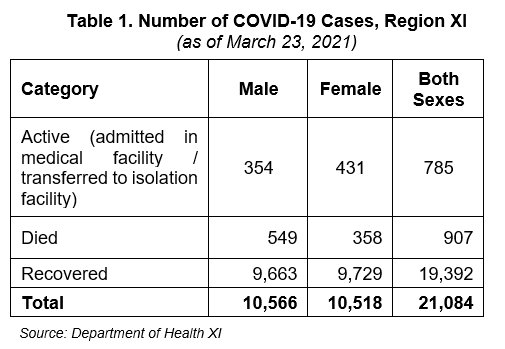
More men have died than women!
Out of the total cases in the region, 907 people or 4.3 percent had succumbed to the disease. Of this, 60.5 percent or 549 are men while 39.5 percent or 358 are women. On the other hand, 92.0 percent of the confirmed cases have already recovered from the disease, which were composed of 50.2 percent women and 49.8 percent men. Meanwhile, there were 785 remained active cases (354 men and 431 women) in the region (Figure 2).

Highest cases in middle ages, more deaths in old age!
In terms of age, more cases were recorded at the 20-49 age group, 62.4 percent. However, the disease has claimed more lives in ages 50 years old and above with 78.1 percent or 708 out of the 907 deaths recorded in the region (Table 2 and Figure 3). Of the total deaths in this age group, 58.2 percent were male while 41.8 percent were women (Figure 4).

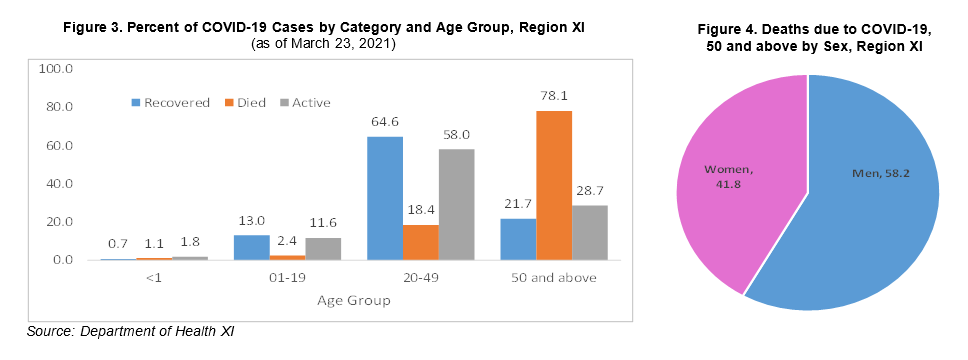
COVID-19 cases in the provinces/city
Among the provinces/city in Region XI, Davao City had the highest number of COVID-19 cases with 64.3 percent, followed by Davao del Norte with 15.7 percent. Davao Occidental had the least with only 1.0 percent of the total confirmed cases in the region (Figure 5).
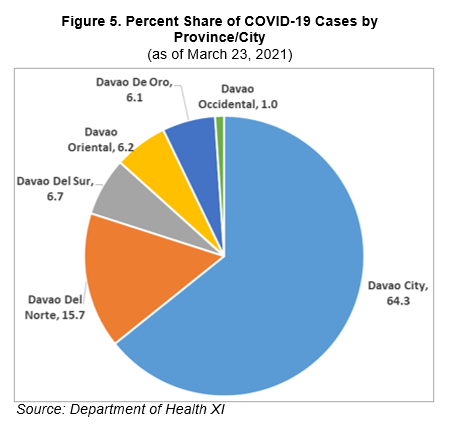
Per 100 confirmed cases, five had died in Davao City, four in both Davao de Oro and Davao del Sur, three in Davao del Norte, and 2 in both Davao Occidental and Davao Oriental. In terms of recovery rate, highest was recorded in Davao Oriental with 95.5 percent, that is about 96 patients recovered for every 100 of the 13,000 confirmed cases in the province. It was followed by Davao Occidental at 94.1 percent recovery rate. Meanwhile, of the 785 active cases in the region, 38.0 percent are recorded in Davao City, 33.5 percent are in Davao del Norte, and 17.6 percent are in Davao de Oro (Table 3).
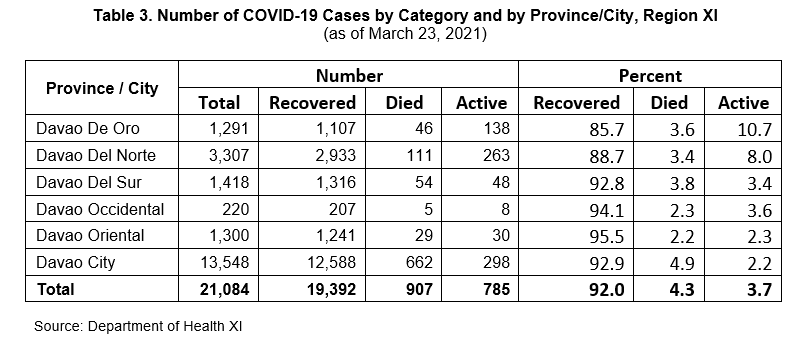
COVID-19 cases amongst health care workers
Meanwhile, as of March 23, 2021, the data provided by DOH XI showed that a total of 2,713 health care workers have been infected with COVID-19. Of the total, 9.5 percent are physicians, 22.4 percent are nurses, 7.0 percent are nursing attendants, 4.4 percent are medical technicians, 18.1 percent are health facility staff, 9.9 percent are other allied health workers, and 28.6 percent are frontliners that include uniformed personnel and volunteers deployed in health and isolation facilities (Figure 6).
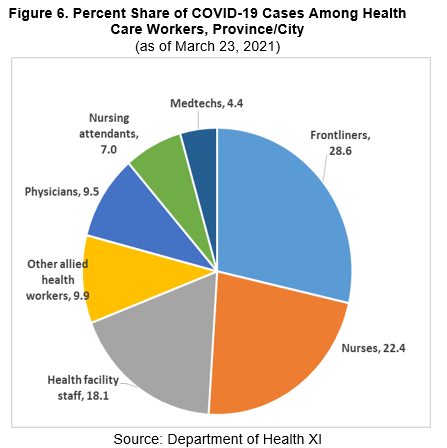
Of the 2,713 health care workers infected, 92.9 percent have recovered while 0.4 have succumbed to the disease. As of the latest data, there are 6.7 percent remained as active cases that are still admitted in a health/isolation facility.

RUBEN D. ABARO, JR., CESE
Regional Director
